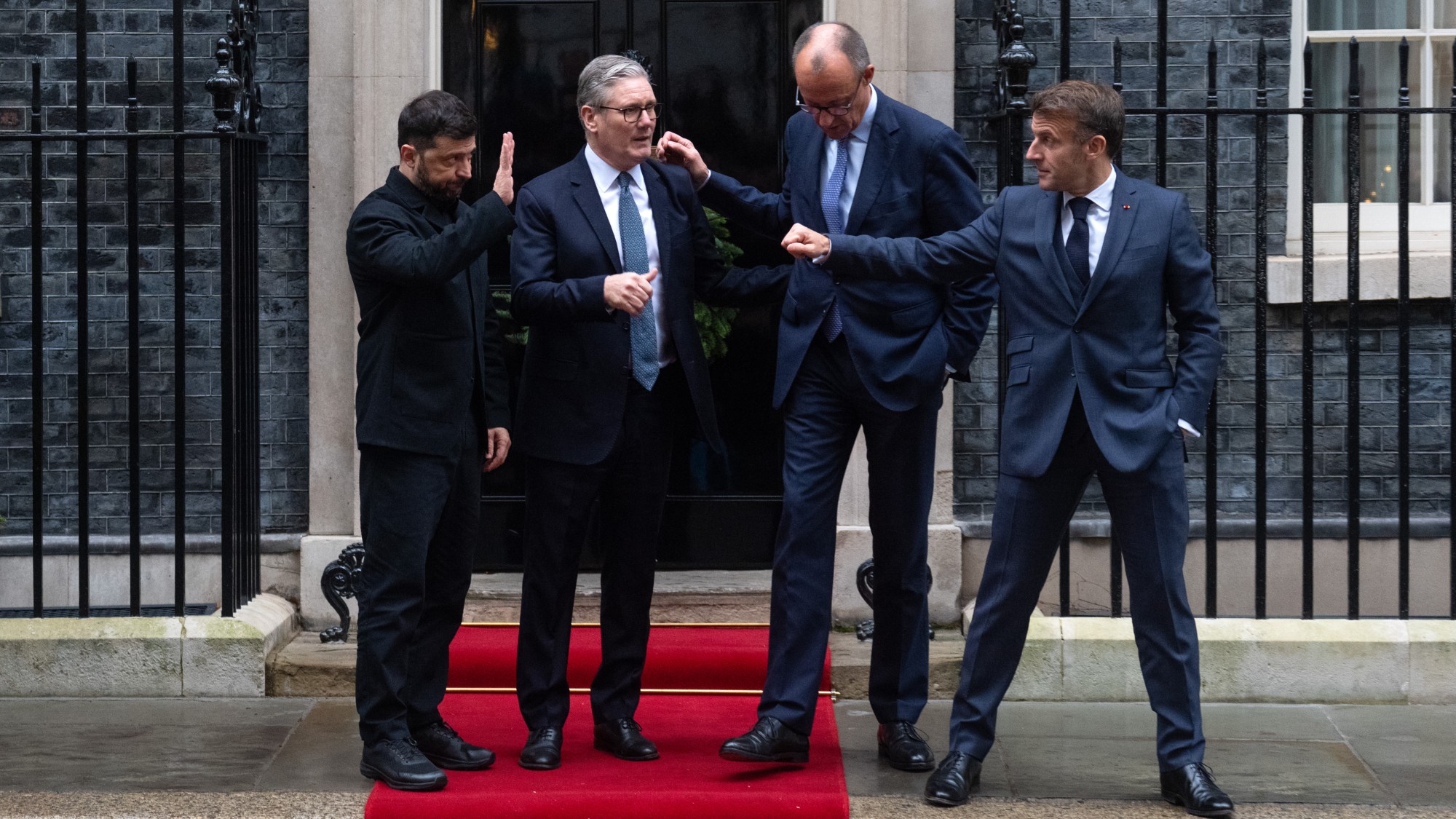Briefing: Running on wind
Oilman T. Boone Pickens is investing a fortune in wind power, and John McCain and Barack Obama have both featured it in their campaign ads. Can wind really solve America’s energy needs?
Oilman T. Boone Pickens is investing a fortune in wind power, and John McCain and Barack Obama have both featured it in their campaign ads. Can wind really solve America’s energy needs?
Why the growing interest in wind power?
Traditional sources of energy are getting more expensive at the same time that concern over global warming is rising. The price of oil has doubled since early 2004, while the cost of coal, which is used to produce half the electricity consumed in the U.S., has tripled in the past two years. Both oil and coal are major sources of the greenhouse gases linked to global warming, with coal accounting for 40 percent of carbon dioxide emissions worldwide. Wind energy, in contrast, is exceptionally clean. By scaling up production, investors hope to make it more affordable to consumers—and profitable for themselves.
The Week
Escape your echo chamber. Get the facts behind the news, plus analysis from multiple perspectives.

Sign up for The Week's Free Newsletters
From our morning news briefing to a weekly Good News Newsletter, get the best of The Week delivered directly to your inbox.
From our morning news briefing to a weekly Good News Newsletter, get the best of The Week delivered directly to your inbox.
How much electricity does wind provide?
Wind currently produces only 1 percent of U.S. electricity, but its share of the market is growing rapidly. Last year, enough wind capacity to power 1.5 million homes came on line in the U.S. In upstate New York, wind producers have been buying up so much land for wind farms that one local official called it “a modern-day gold rush.” Investment prospects have been boosted by a new generation of wind turbines—some standing 20 stories high with blades that span up to 200 feet—that generate electricity with far greater efficiency than ever before. Large wind farms have also recently sprouted in California, Iowa, and a handful of other states. But Texas is leading the way and is fast becoming one of the largest producers of wind power in the world.
What makes Texas wind country?
It has two essential ingredients: lots of windswept open spaces, which are good for generating power, and several major cities nearby. The state also has an accommodating regulatory regime. Last year, the Texas Public Utility Commission approved the construction of new transmission lines to handle up to 25,000 megawatts of electricity by 2012, linking wind farms in West Texas and the Panhandle to Dallas, Houston, and other markets. Ranchers compete to have turbines located on their land, earning revenue from wind the way previous generations made money from oil leases. Wind currently produces 3 percent of the state’s electricity, but Texas officials expect that share to expand significantly. “We’re No. 1 in wind in the United States,” says Texas Land Commissioner Jerry Patterson, “and that will never change.”
A free daily email with the biggest news stories of the day – and the best features from TheWeek.com
Why aren’t other states as enthusiastic?
Wind energy is still more expensive to produce than energy from coal and other carbon-based sources. Transmission is also a problem. The Department of Energy estimates that Texas, the Dakotas, and Kansas have enough wind to supply the electricity needs of the entire nation. But their distance from urban markets (“load centers” in utility-speak) makes transmission difficult. “The windiest sites have not been built because there is no way to move that electricity from there to the load centers,” says Gabriel Alonso of Horizon Wind Energy. In addition, much of the grid is congested, with little capacity for added power. And because authority over the grid is diffused among individual states and hundreds of private companies, coordinated action is difficult. “We still have a Third World grid,” says New Mexico Gov. Bill Richardson, a former secretary of energy. To circumvent existing transmission lines, some entrepreneurs have taken to investing in wind projects offshore.
What are the advantages of going offshore?
Wind tends to be faster and steadier offshore, and it’s easier to transport large turbines by sea than over rural roads. More important, offshore projects can be located near major load centers along the coast. In June, a developer in Delaware signed a deal to install more than 60 turbines off the state’s Atlantic coast. New York, Rhode Island, and other coastal states are exploring similar deals. But in Massachusetts, homeowners on Nantucket Island and Martha’s Vineyard objected to the prospect of their sea views being cluttered by wind turbines, scuttling a planned offshore project called Cape Wind. In addition to aesthetic objections, offshore wind farm still cost roughly twice as much to set up as land-based ones.
So what’s the future of wind?
Both Barack Obama and John McCain support wind energy. But its competitiveness against cheaper, coal-powered plants depends on federal production tax credits, which effectively subsidize clean alternative energy. The federal bailout legislation passed in October only extended wind credits for one year, leaving the industry with no assurance of long-term stability. Still, the Department of Energy predicts wind power could produce as much as 20 percent of U.S. electricity by 2030. Last summer, Iberdrola, the Spanish energy giant that owns wind farms in New York, announced it would invest another $2 billion to build more turbines in the U.S. It’s doubtful, though, that significant additional power can be delivered to consumers without an ambitious expansion of transmission lines. Such a build-out will undeniably be expensive. But in the context of soaring energy costs, including a $700 billion annual tab for foreign oil alone, making accommodations for wind power may begin to look like a bargain.
The Pickens plan
No one better exemplifies the shifting landscape of the energy economy than 80-year-old Texas billionaire T. Boone Pickens. The former oil wildcatter is planning the largest wind farm in the world on 150,000 acres in the Texas Panhandle. His $10 billion project should be capable of producing 4,000 megawatts, enough to power nearly 1 million homes. “I have the same feelings about wind,” Pickens says, “as I had about the best oil field I ever found.” His “Pickens Plan,” which he has advertised heavily on national television, calls for transforming the U.S. into “the Saudi Arabia of wind power” with wind turbines stretching across Texas and the Great Plains and a $200 billion investment in transmission lines to carry the power to load centers. Pickens also advocates a transition to natural-gas-powered automobiles. Pickens cites the declining productivity of his oil wells as a key impetus for his new crusade. “I like wind because it’s renewable and clean,” he says. “Decline curves finally wore me out in the oil business.”
-
 Will there be peace before Christmas in Ukraine?
Will there be peace before Christmas in Ukraine?Today's Big Question Discussions over the weekend could see a unified set of proposals from EU, UK and US to present to Moscow
-
 Quiz of The Week: 6 – 12 December
Quiz of The Week: 6 – 12 DecemberQuiz Have you been paying attention to The Week’s news?
-
 The week’s best photos
The week’s best photosIn Pictures A man's best friend, the elephants in the room, and more
-
 Has Zohran Mamdani shown the Democrats how to win again?
Has Zohran Mamdani shown the Democrats how to win again?Today’s Big Question New York City mayoral election touted as victory for left-wing populists but moderate centrist wins elsewhere present more complex path for Democratic Party
-
 Millions turn out for anti-Trump ‘No Kings’ rallies
Millions turn out for anti-Trump ‘No Kings’ ralliesSpeed Read An estimated 7 million people participated, 2 million more than at the first ‘No Kings’ protest in June
-
 Ghislaine Maxwell: angling for a Trump pardon
Ghislaine Maxwell: angling for a Trump pardonTalking Point Convicted sex trafficker's testimony could shed new light on president's links to Jeffrey Epstein
-
 The last words and final moments of 40 presidents
The last words and final moments of 40 presidentsThe Explainer Some are eloquent quotes worthy of the holders of the highest office in the nation, and others... aren't
-
 The JFK files: the truth at last?
The JFK files: the truth at last?In The Spotlight More than 64,000 previously classified documents relating the 1963 assassination of John F. Kennedy have been released by the Trump administration
-
 'Seriously, not literally': how should the world take Donald Trump?
'Seriously, not literally': how should the world take Donald Trump?Today's big question White House rhetoric and reality look likely to become increasingly blurred
-
 Will Trump's 'madman' strategy pay off?
Will Trump's 'madman' strategy pay off?Today's Big Question Incoming US president likes to seem unpredictable but, this time round, world leaders could be wise to his playbook
-
 Democrats vs. Republicans: who are US billionaires backing?
Democrats vs. Republicans: who are US billionaires backing?The Explainer Younger tech titans join 'boys' club throwing money and support' behind President Trump, while older plutocrats quietly rebuke new administration